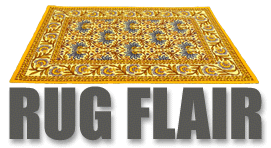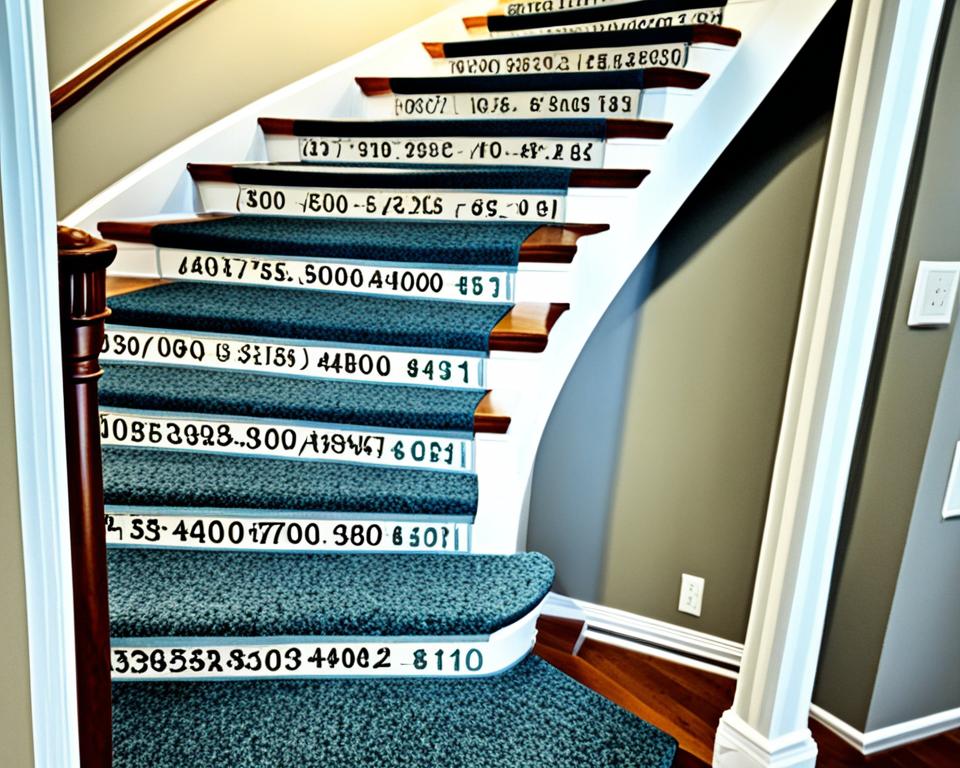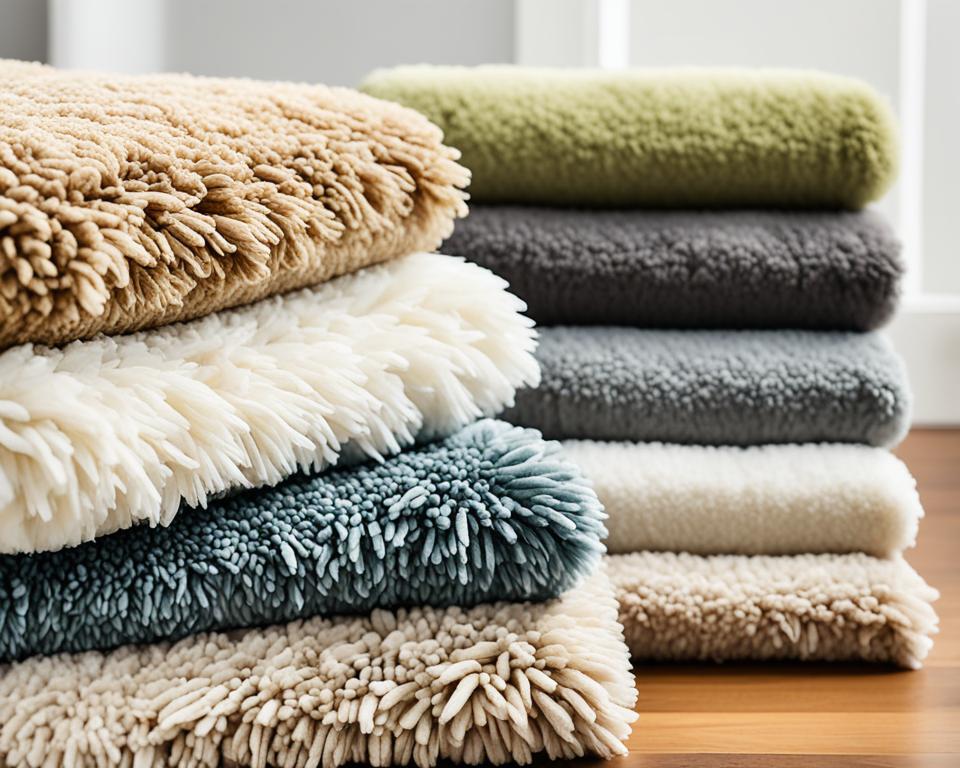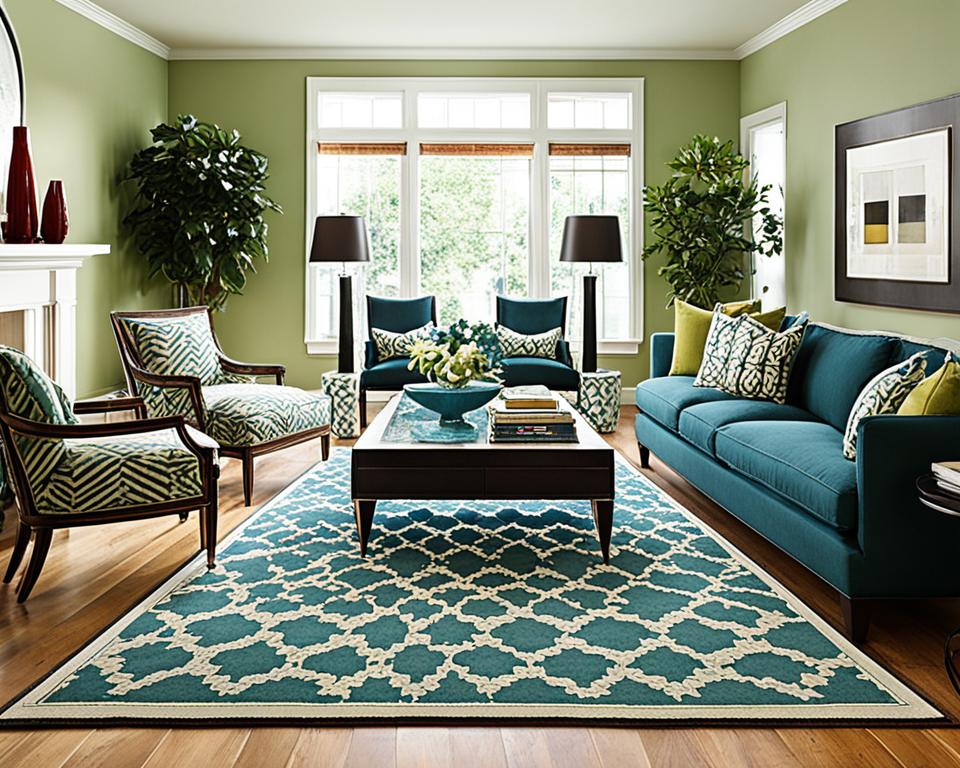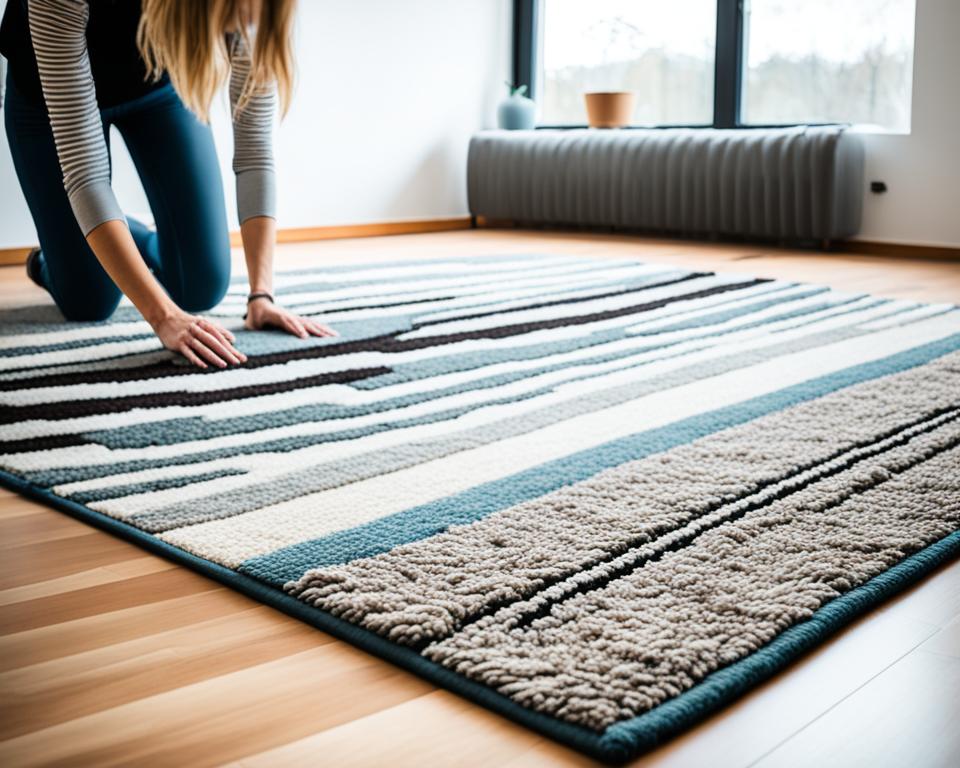Are you pondering over how much carpet for stairs you’ll need to enhance the beauty and comfort of your home? Calculating the perfect amount can seem daunting, but don’t let it get you tangled up. With a handy stair carpet calculator, you can weave through the numbers with ease. From riser heights to tread runs, every inch counts when ensuring full stairs carpet coverage. To assist you, imagine elegantly carpeting each step to not only cushion your every stride but also to elevate your home’s décor.
Taking accurate measurements is the first step in determining the carpet sq ft for stairs, ensuring a seamless transition from one level to the next. This guide is here to unravel the mystery of stair carpeting and steer you toward a clear path for your home. Think of this tool as your compass in the sea of flooring options, promising to accurately chart out the perfect size of the carpet for your staircase voyage.
Key Takeaways
- Utilize a stair carpet calculator to accurately estimate the coverage needed.
- Measure every riser and tread, as each dimension is crucial for the stairs carpet coverage.
- Begin by understanding the riser rise, effective tread run, and landing depth.
- Factor in the stair width and nosing details for precise carpet sq ft for stairs.
- Include an additional allowance in your calculations for any potential discrepancies.
- Choose the right carpet amount to match your staircase’s width for an exact fit.
Understanding Stair Carpeting Basics
Embarking on the journey of stair carpet measurements may initially feel like a complex endeavor. To help you navigate this process with confidence, we’ve compiled an essential guide tailored to assist you in estimating carpet for staircase projects. Consider this your comprehensive staircase carpeting guide, ensuring you capture all the facets of stair coverage, from the basics to the nuances.
Every staircase has its unique personality, characterized by dimensions that determine the carpeting requirements. Visualize each step as a distinct entity, where the riser represents the vertical component and the tread is where your foot lands. The elegance lies in the details, such as the nosing or overhang – an ornamental yet functional feature that often extends beyond the face of the riser.
Commonly, a staircase width hovers around the 3 feet mark unless it’s a custom design veering off the standard path. To achieve that professionally fitted look, an extra allowance is factored into the carpet’s width, typically around 2 inches. This allotment is not merely a cosmetic perk; it is a strategic move to conceal the rough edges, embodying exquisite craftsmanship.
As you ascend the staircase of measurement mastery, remember that precision is key. You’ll encounter terms like ‘tread run’, ‘riser rise’, and ‘nosing overhang’, each bringing you closer to an accurate estimation. It’s not just about covering the area; it’s about sculpting a fitting tapestry that harmoniously blends with the architecture of your home.
Syncing these measurements in tandem, let’s chart out a table to demystify the numbers:
| Stair Component | Measurement (in) | Role in Carpet Estimation |
|---|---|---|
| Tread (horizontal) | Width varies | The surface area your foot contacts |
| Riser (vertical) | Height varies | The vertical component of each step |
| Nosing/Overhang | Extension beyond riser | Adds to tread depth and aesthetic appeal |
| Stair Width | Typically around 36 inches | The span across which carpet must extend |
| Allowance | Additional 2 inches | Ensures full coverage and hides seams |
Your journey through the realms of stair carpeting is advancing with each step measured. In preparation, you’ve acquainted yourself with the essential variables, setting the stage for a smoothly executed carpet installation that is nothing short of exactitude. With the foundational knowledge secure, you’re now equipped to navigate the subsequent phases of your stair carpeting voyage.
Preparing to Measure Your Staircase
Before taking the plunge into the world of stair carpeting, it’s imperative to gather your tools and understand the landscape. Accurately measuring your staircase is the cornerstone of obtaining that perfect carpet fit, which not only enhances the safety but also accentuates the elegance of your home. Your tape measure will be your faithful ally in this venture, and a pen and paper will be the trusted sidekicks to ensure you don’t miss a single detail.
Armed with these tools, you will embark on a journey to capture the essence of your staircase. Whether your domain features a classic straight ascent or the allure of winding steps, knowing the characteristics of your stairway will propel you into the realm of precision.
Tools You’ll Need for Accurate Measurements
Engage in the preparatory rites by equipping yourself with a reliable tape measure, an indispensable apparatus for carpeting stairs calculator tasks you’re about to undertake. Secure the width and depth of each stair tread with unwavering precision, noting the riser’s stance like a sentry at the gate. Aspire to the realm of accuracy by rounding measurements to the nearest foot or meter and scribe them devotedly on your pen and paper—your envoys of remembrance.
Identifying Types of Staircases
Behold the architectural tapestry before you—does it spiral skyward or chart a straight course? Your staircase type shapes the destiny of your carpet’s journey. From the coiled splendor of a spiral ascent to the regal bearing of a straight set crowned with landings, each warrants a unique approach to stairway carpet measurements. Consider each section a chapter in your stairway story, and scripting these measurements coalesces the plot of your carpeting narrative.
Determining Total Stair Numbers
Summon your attentiveness as you count the steps of your stately vertical promenade. This number will be your multiplier, the amplifying factor in the calculus of comfort underfoot. Pair it with the measure of a single, steadfast step to unravel the tapestry of carpet required—a testament to your calculating carpet for stairs prowess. Should your staircase bestow the gift of landings, treat them as the protagonists of their own tale, measuring and adding their expanse to the overall odyssey of your staircase coverage aspirations.
Step-by-Step Guide to Carpet Sizing
Accurately estimating carpet for staircase projects is just as much about the numbers as it is about ensuring a snug fit and stylish finish. Take heart, as you’re about to embark on a step-by-step exploration into the essentials of stair carpet measurements. Think of it as a craft—where precision meets artistry.
Begin the sizing journey with a single stair tread, where width takes the spotlight. Here, every inch counts, with an added margin creating room for that professional edge of carpet. Itemize these figures with care, just as a tailor would with fabric, to clinch full stairs carpet coverage.
Next, align your tape measure with the stair’s profile, capturing the combined height of tread and nosing, along with the stature of the riser—those oft-overlooked vertical faces that elevate each step to greater heights. Adhere to the mantra of ‘more is better’ and round up these values, for it’s the excess that guards against the peril of shortfall.
Stitch together the broad strokes by multiplying the area of a single step by the staircase’s step count. Add into the mix the breadth and depth of any landings—it’s not just the journey up and down, but also the flat intermissions that demand your carpet’s embrace.
| Step Detail | Measurement Guide | Coverage Calculation |
|---|---|---|
| Stair Tread Width | Measure tread, add margin. | Width x Number of Steps |
| Stair Riser & Nosing | Combine height of tread, riser and nosing. | (Riser + Tread + Nosing) x Number of Steps |
| Landing Area | Length x Depth of landing | Add landing area to step coverage. |
| Waste Allowance | Account for errors, add 10%. | Total Area + 10% Waste |
In the final act, sprinkle your calculations with an allowance for waste—a prudent hedge against the unforeseen twists of installation. Only then can you confidently face the march of steps ahead, knowing your forethought has woven a tapestry sized for your home’s grandest of stages.
Calculating Total Carpet Area for Stairs
When embarking on the task of estimating carpet for a staircase, the process begins with a detailed analysis of each step. The stair carpet measurements you’ll acquire serve as the fundamental building blocks for calculating the overall carpet sq ft for stairs. Your precision in this initial phase paves the way for a flawless installation, ensuring each step is adorned with the perfect cut of carpet.
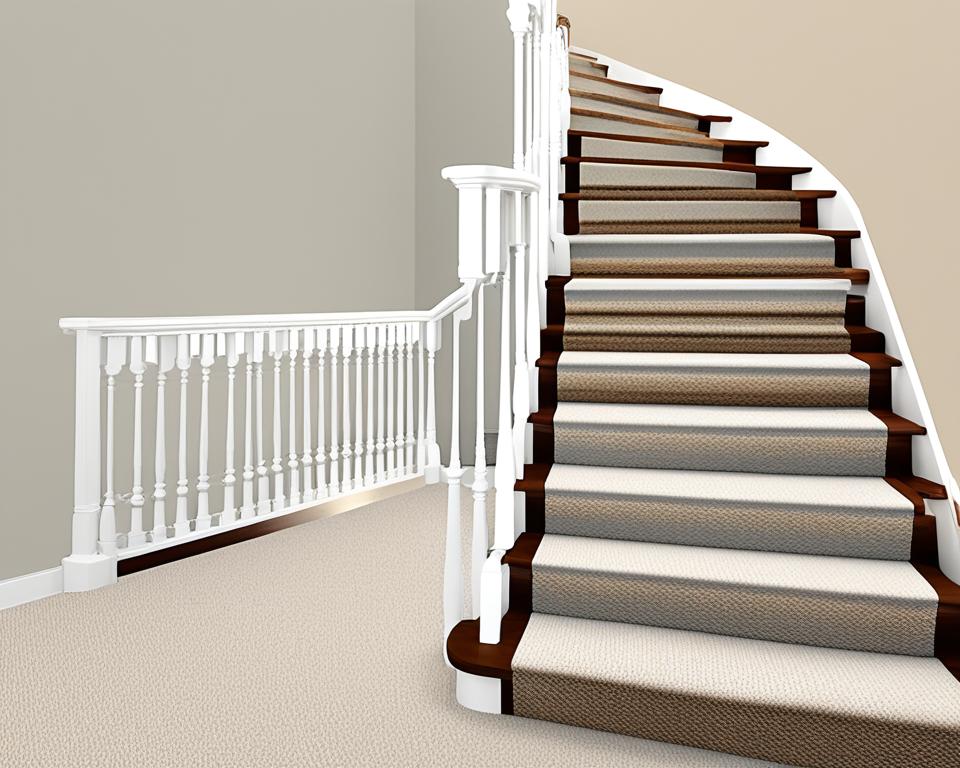
Starting with the tread and riser, you measure these essential parts of a stair to ascertain both the visible surface and underlying structure that will be covered by the carpet. This dimension is critical because it dictates the amount of carpet that will directly interact with daily foot traffic. In essence, it lays the foundation for the carpet’s functionality and aesthetic appeal.
Incorporating the Tread and Riser
Fascinatingly, the tread and riser collectively tell the tale of your staircase’s dimensions. By calculating carpet for stairs, you take their individual measurements and fuse them to represent a single stair. Multiply this fused measurement by the total number of stairs to envision the carpet expanse required for these core areas.
Accounting for Stair Nosing and Overhang
However, your attention to detail doesn’t end there. Stair nosing and overhang embody the subtle yet significant extensions that contribute to your staircase’s grandeur and, consequently, to your carpet needs. Whether your nosing is rounded or specially shaped, the calculus of carpet sq ft for stairs must encompass these elements for a truly seamless finish.
Be generous in your calculations; factor in an additional allowance for nosing overhang to ensure you’re prepared for the unique contours of your staircase. Such meticulous planning exemplifies the art of estimating carpet for staircase projects with precision. Fortify your measurements and your staircase will soon step into a new realm of elegance, swathed in the perfect carpet it deserves.
| Stair Component | Calculation Method | Why It’s Important |
|---|---|---|
| Tread and Riser | Measure and add both dimensions then multiply by the number of stairs | Base calculation for main surface area coverage |
| Nosing | Measure including overhang and add as per nosing type | Ensures carpet wraps around stair details for complete coverage |
| Overhang Allowance | Add an extra inch per stair to account for depth | Prevents shortage of carpet at the stair’s edge |
How Much Carpet for Stairs: Ensuring Precise Fit
When considering stair carpet measurements, precision is not a luxury—it’s a necessity. As you look to add warmth and style to your staircase, the effort you invest in determining the exact carpet sq ft for stairs pays off in the seamless fit and finish of your new carpet. Begin with a thorough assessment of your staircase, taking into account every inch of space that will be caressed by the carpet. We’ll guide you through the process of quantifying stairs carpet coverage, tailoring it to your unique staircase to ensure a glove-like fit.
First, let’s address the width. It’s the starting point and shapes the landscape of your carpet needs. Appropriately measuring the width is akin to setting the foundation of a building—vital and unshakable. But don’t just stop at the visible surface; remember to calculate the hidden aspects. The depth that the nosing adds is just as important to consider, providing that polished look as it gracefully overhangs.
Delving deeper, we unite the measurements of each tread and riser, along with the nosing, combining them to give us the length of carpet required for each step. With the total number of stairs in mind, we multiply, we add, and we adjust for any allowances or overhangs. It’s a dance of numbers, with each step cursory to the flow of your carpet’s installation.
The final flourish in our precise measurement soiree is the addition of a waste and error margin. Why? Because foresight in estimation means not getting caught short on material. A typically recommended allowance is an additional 10% of your calculated carpet area. This buffer accounts for discrepancies that can occur, ensuring you’re not left with a staircase that’s partially dressed.
Our carpet coverage adventure concludes with a neatly tied ribbon of numbers and figures that represents the entirety of your staircase. These calculations, meticulous as they may be, are the surest path to a staircase that not only looks utterly inviting but feels like home with every step you take.
| Measurement Type | Detail | Importance |
|---|---|---|
| Staircase Width | Measured edge to edge | Defines the horizontal coverage of carpet |
| Tread and Riser | Cumulative measurement adds depth | Ensures vertical and surface area are covered |
| Nosing | Address overhang in measurements | Allows carpet to wrap around for a finished look |
| Allowance | Add 10% for waste/error margin | Prevents underestimating material needs |
With your carefully calculated measurements, you’re well-equipped to embark on the transformative journey of stair carpeting. Relish in the thought that your steps will soon be caressed by precisely the right amount of carpet, lavish and exact, just as they should be.
Stairway Carpet Measurements: Width and Length
Embarking on your staircase carpeting project begins with understanding the crucial role of accurate stair carpet measurements. Ensuring that you have the right width and length is paramount for a flawless fit. Let’s delve into why these dimensions are so significant and how to calculate them effectively for your stairway.
Why Width Matters for Stairway Carpet
When it comes to staircase carpeting, the width of your carpet plays an essential role. It must cover the full breadth of the stairs to create an even and aesthetically pleasing look. Width measurements cater to potential inconsistencies, such as deviations from construction norms or unique stairway design elements. An extra bit of carpet width allows for necessary adjustments and provides room for tucking edges neatly against the walls or stair stringers, evoking a tailored finish. Your staircase deserves this attention to width as it ultimately contributes to the carpet’s balanced appearance and functional durability.
Calculating the Length: From First to Last Step
Mastering the art of estimating carpet for staircase projects goes beyond mere width considerations; it encompasses a detailed calculation of the carpet’s length. Measuring each step’s riser and tread, and factoring in the nosing overhang, you lay the groundwork for the entire staircase’s coverage. The length calculations determine how much carpet you’ll need from the very first step to the last, ensuring each riser and landing is comfortably clad in your chosen fabric. Don’t forget to include an allowance for length, an extra provision safeguarding against measurement errors or discrepancies and guaranteeing a snug, wall-to-wall fit.
Consider these insights as you set out to measure and calculate carpet for stairs—a decisive step towards transforming your staircase into a statement of elegance and comfort.
Adding Landings to Your Carpet Calculation
When you set out to craft the perfect staircase carpeting guide, landing areas deserve a spotlight of their own. Unlike the consecutive steps that lead up to them, landings are the plateaus offering a respite, an area where one can pause to admire the craftsmanship beneath one’s feet. Your mission in estimating carpet for staircase transitions is not complete without incorporating these special spaces into the overall plan.
As you measure the volume of carpet for stairs, treating landings as independent entities is crucial. These intermissions in your stairway not only serve a functional purpose but also add a layer of complexity to your carpeting project. Each landing calls for its own set of dimensions—length and width—attention to which ensures no corner is left bare, no edge unadorned.
To accurately quantify how much carpet covers both your stairs and landings, envision the landing as a canvas awaiting your calculation. Here’s how:
- Begin by measuring the length from the starting edge to the opposite end of the landing.
- Proceed with the width, ensuring you stride from one side to the other, capturing the entire breadth of the space.
- Combine these measurements to ascertain the square footage, akin to a cartographer charting a newly discovered land.
- Add this number to the cumulative area of your steps to unveil the grand total—your staircase in its entirety, wrapped in the soft luxury of well-chosen carpet.
By following these steps, you ensure that every inch of your stairway is considered, and your calculations are astute, leaving no landing behind.
| Stair Component | Length | Width | Total Square Footage |
|---|---|---|---|
| Steps | Measure each rise and run | Matching carpet width | Calculate and sum total |
| Landing | From edge to opposite end | Span from side to side | Add to steps’ total area |
In the realm of staircase carpeting, landings can not be mere afterthoughts. Instead, they should be celebrated as individual stages of your staircase’s elegant journey—a journey that culminates in the harmony of form and function, the seamless blend of every tread and landing underfoot. Keep this guide at your side as you measure, calculate, and manifest the stairway that not only serves your steps but also speaks to your style.
Estimate Carpet for Staircase with Multiple Flights
When it comes to estimating carpet for staircase projects, those with multiple flights present an intricate tapestry of measurements. It’s akin to assembling a jigsaw puzzle—each piece must be meticulously measured and fit to create the entire picture. With this guide, your approach to calculating carpet for stairs that cascade through multiple levels will be as refined as the patterns you choose to grace them.
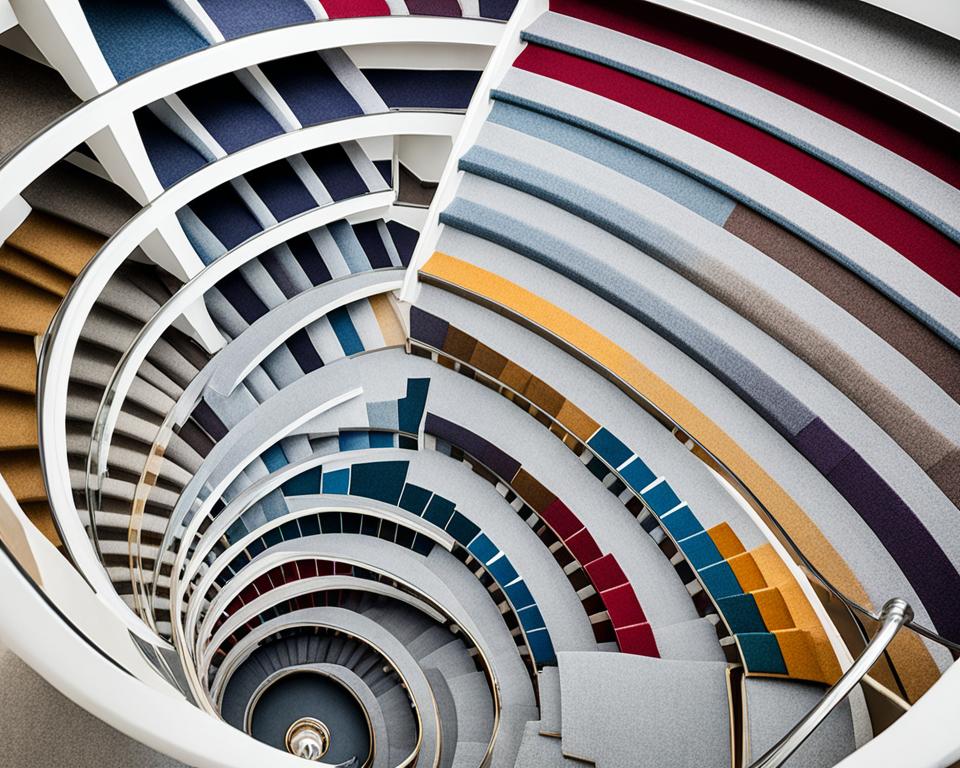
Dealing with Unique Stair Flights
Every staircase harbors its own blueprint, which can pose a delightful challenge in the realm of a staircase carpeting guide. Unique flights may vary in size due to the design intentions or space constraints, therefore each section demands your undivided attention. Your measurement tool is your compass through the myriad dimensions—take note of each rise and tread with precision, considering the possibility of varied sizes within the same staircase system.
Combining Measurements for Multi-Level Stairs
Upon gathering the dimensions of each individual flight and landing, your next step in calculating carpet for stairs is the act of synthesis—laying each measurement side by side to comprehend the scope of the canvas you are to cover. This process involves combining lengths and widths to find the total square footage, with an additional allowance included to accommodate for any miscuts or adjustments during installation.
| Stair Flight | Length (ft.) | Width (ft.) | Calculated Area (sq. ft.) | Allowance (%) | Total Area (sq. ft.) |
|---|---|---|---|---|---|
| First Flight | 15 | 3 | 45 | 10 | 49.5 |
| Second Flight | 14 | 3 | 42 | 10 | 46.2 |
| Landing | 5 | 3 | 15 | 10 | 16.5 |
| Total for Installation | 112.2 | ||||
The aggregation of these numbers yields the amount of carpet required to dress your staircase in full splendor. Remember, the adage ‘measure twice, cut once’ is a steadfast rule in the domain of staircase carpeting, saving you both time and resources. Allow this holistic approach to guide you through the array of measurements, and you’ll find the end result is well worth the meticulous planning.
Staircase Carpeting Guide: Selecting the Right Material
Selecting the right material for your staircase carpeting involves attention to various factors to ensure durability, visual appeal, and comfort underfoot. With staircases being a high-traffic zone, picking a material that can withstand regular wear and tear while complementing your home’s design is essential. In our comprehensive staircase carpeting guide, we aim to support you in making an informed choice that will keep your stairs comfortable and stylish for years to come.
Factors Affecting Carpet Material Choice
When you’re considering how much carpet for stairs you will need, it’s not just about quantities; it’s about quality too. Different carpet materials offer varied textures, patterns, and resistance to footfall. Wool, for example, brings a feeling of luxury and warmth, while synthetic fibers like nylon are praised for resilience. Whether you prefer the plushness of thick carpets or the sleekness of a low pile, the choice affects both the carpet’s aesthetics and its longevity on your staircase.
Durability and Maintenance Considerations
As you delve into calculating carpet for stairs, ponder the level of durability and ease of maintenance that different materials offer. In the long journey of staircases, carpets must put up a solid front against the daily parade of feet. Materials such as wool and nylon stand out in the arena for their sturdiness and are remarkably forgiving when it comes to cleaning up after those accidental spills. And if you’re looking for a hassle-free maintenance experience, a low-pile carpet could be your steadfast companion, showing less wear over time compared to their high-pile counterparts.
| Material Type | Texture | Durability | Maintenance | Suitability for Stairs |
|---|---|---|---|---|
| Wool | Soft & Luxurious | High | Easy to clean, but prone to staining | Highly suitable for low to moderate traffic areas |
| Nylon | Smooth & Resilient | Very High | Resistant to stains and easy to maintain | Ideal for high-traffic staircases |
| Polyester | Varying Textures | Moderate | Basic cleaning required | Suitable for moderate traffic areas |
| Olefin | Resistant to moisture | Moderate to High | Easy to clean, resists mold and mildew | Good for basement staircases or damp conditions |
| Low-pile varieties | Less Cushiony | High | Less trapping of dirt, easier to vacuum | Recommended for heavy use stairs |
Choosing the optimal carpet for your staircase doesn’t have to be overwhelming. Reflect on these considerations, assess your daily demands, and align them with your personal taste. Whether you’re drawn to the endurance of synthetic fibers or the tactile luxury of wool, your selected material will lay the foundation for staircase beauty and functionality. And remember, a smidge more in upfront cost for a durable, easy-to-maintain carpet can mean less spending in the long run.
Calculating Carpet for Stairs: Cost Considerations
When you dive into the world of stair renovations, determining how much carpet for stairs you need intertwines with understanding the cost implications involved. It’s not merely about measuring the carpet sq ft for stairs; it also hinges on the types of carpet you choose and the nuances of the installation process.
A pivotal aspect to consider is the installation fee, which varies significantly based on regional pricing discrepancies and the intricacy of the staircase itself. In addition, if you have existing furniture that needs to be moved or other preparatory work, these factors could escalate the overall expenditure.
Given these variables, it’s prudent to gather multiple estimates from reputable professionals before reaching a decision. Doing so empowers you with a comprehensive view of the financial landscape, allowing you to budget effectively for your staircase carpeting project.
To navigate this financial journey with ease, it’s recommended to employ a staircase carpeting guide that can help you decode the overall square footage required for your stairs – a primary driver of cost. Remember, each stair is a potential canvas for your new carpet, and the total number of these canvases contributes to the square footage.
Here’s a breakdown of considerations for a cost-effective carpet purchase:
- Identify carpet quality versus cost efficiency based on your preferences and usage.
- Estimate the total square footage needed by using your precise staircase measurements.
- Add a standard waste percentage to your total square footage to account for cutting and fitting.
- Compare quotes that include material and labor costs to ensure comprehensive budgeting.
A detailed overview of costs relative to stairs carpet coverage is best illustrated through an example:
| Material Chosen | Cost per Sq Ft | Total Sq Ft (incl. waste) | Installation Fees | Additional Costs | Total Estimated Cost |
|---|---|---|---|---|---|
| Nylon Carpet | $3.50 | 100 | $500 | $100 (Furniture moving) | $850 |
| Wool Blend Carpet | $6.00 | 100 | $500 | $100 (Furniture moving) | $1,100 |
| Berber Carpet | $4.50 | 100 | $500 | $100 (Furniture moving) | $950 |
This snapshot encapsulates the correlation between carpet choice, coverage area including waste provision, and the estimated total cost, guiding you through the financial aspect of tailoring your staircase with new carpeting.
With this information in hand, you’ll be equipped to make an informed decision, striking a balance between quality, aesthetics, and cost, ensuring your staircase is both practical and visually engaging.
Stairs Carpet Coverage: Waste and Overage
When you set out to fit your stairs with the perfect carpet, you’ll discover that achieving flawless stairs carpet coverage involves more than just choosing a design that suits your aesthetic. It requires a careful approach to calculating carpet for stairs, one that meticulously reduces waste and anticipates overage, ensuring every inch of your staircase is impeccably dressed.
Reducing Waste by Precise Measurements
To minimize waste effectively, you must embark on a journey of precision, positioning your tape measure with the poise of an artist and the accuracy of an engineer. As you detail each aspect of your staircase, from tread to riser to nosing, remember that your goal is to uncover the exact carpet sq ft for stairs needed. Not only does this level of meticulousness help you cut costs, but it also reflects an environmentally conscious effort to decrease material waste.
Adopting the mindset of precision and care in calculating carpet for stairs translates to a perfect marriage of form and function. It means there’s just enough carpet to elegantly cascade over each step, with little to no leftovers whispering tales of measurement conquests.
Why Allowing Overage is Essential
However, even the most accurate measurements can’t account for all the whims of a staircase. That’s why seasoned pros always recommend adding an overage margin—typically between 10% and 20%. This approach to estimating carpet for staircase projects allows room for the unexpected and assures that surplus carpet is at hand to rectify any miscalculations or mishaps encountered during installation.
An extra cushion of carpet is more than a backup plan; it’s a cornerstone of a successful installation. It saves you from the potential stress of mid-project shortages and the inconvenience of last-minute orders. So when you’re contemplating how much carpet for stairs is truly necessary, factor in that little extra. It’s the thread that weaves a smooth process from the planning stages to the final step of your stairway transformation.
Conclusion
As you approach the finale of your stair carpeting journey, reflect on the path taken to arrive at this critical juncture. The art of calculating carpet for stairs deals with more than numbers; it weaves a narrative combining precision with the personal touch to transform your home. Utilizing a carpet calculator has equipped you to measure the carpet sq ft for stairs accurately while integrating an understanding of your staircase’s individual character—its rises, runs, and the graceful nosing that defines each step.
Armed with this wisdom, your venture into estimating carpet for staircase projects becomes less about guesswork and more about guaranteeing an outcome that marries form, function, and style. Every inch counted and every step considered leads to avoiding wastage, conserving resources, and ultimately, indulging in the comfort of a carpet that’s cut to precision—a testament to the efforts invested in the planning phase.
Remember, your home deserves a staircase that’s not only safe and sound underfoot but also one that visually echoes your personal aesthetic. May this guide empower you to make confident choices, ensuring each measurement is a step towards a staircase that beautifies and enhances the essence of your living space.
FAQ
How do I use a carpet calculator for stairs?
Using a stair carpet calculator involves inputting the measurements of your staircase’s risers and treads, along with the number of steps and any landings. The calculator will then determine the total square footage of carpet needed for your stairs.
What measurements do I need to calculate stair carpet coverage?
You will need to measure the width and depth of each tread, the height of each riser, dimensions of any landings, and the width of the staircase. Don’t forget to include allowances for overhang and extra carpet for tucking and fitting.
What tools are necessary for accurate staircase measurements?
A reliable tape measure is essential for taking measurements. You may also need a pen and paper to record the dimensions, and possibly a calculator for determining the total carpet area needed.
How do I measure stairs with landings?
Measure the landing separately from the stairs, noting its length and width, then add this area to your total measurement for the staircase to determine the overall amount of carpet needed.
What should I consider when choosing carpet material for my staircase?
Look for durability, comfort, and ease of maintenance in a carpet material. Materials such as wool and nylon are durable and ideal for high-traffic areas. Also, consider the pile height and the pattern or texture, which should complement your home’s design.
How much additional carpet should I order for waste and overage?
It is recommended to add 10% to 20% more carpet to your order to account for cutting, fitting waste, and any unforeseen measurements or installation errors.
Why is it important to account for stair nosing and overhang in measurements?
Stair nosing and overhang must be covered by the carpet for a complete and seamless installation. Including these features in your measurements ensures that you have sufficient carpet to cover the entire surface of your stairs.
Can I estimate the cost of carpeting for my stairs on my own?
Yes, you can estimate the cost by calculating the total square footage of the carpet needed and then multiplying that by the price per square foot of the carpet material. Don’t forget to include costs for installation and additional expenses such as moving furniture, if necessary.
How do I calculate carpet needs for a staircase with multiple flights?
Measure each section of the staircase, including individual flights and landings, separately. Then combine these measurements to determine the total carpet needed for the entire system. Include additional allowances for installation waste.
Does the width of the staircase affect how much carpet I need?
Yes, the width of the staircase determines the amount of carpet needed to cover it completely. Make sure to measure the staircase width accurately and add a small allowance for fitting and tucking the carpet edges.
